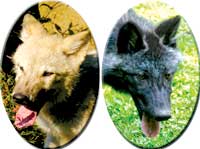Conservation ambassadors
Cody and Shalimar are gray wolves, but they don’t look gray. Cody, a 4-month-old male, is almost black, while Shalimar, a 3-month-old female, has a cream-colored coat. And while gray wolves—also called timber wolves or tundra wolves—were once native to Western North Carolina, these pups were born in a wildlife facility in Montana before being transported to the Western North Carolina Nature Center. The last wild wolves vanished from these mountains in the 1800s. Today, gray wolves are found only in Canada and parts of the northern United States, according to Sarah Oram, director of the nonprofit Friends of the WNC Nature Center, which provides financial support for the facility and its programs.

Beginning Wednesday, Sept. 5, the public will have a chance to see Cody and Shalimar, who recently came to live at the Nature Center. But if you want to get a glimpse of the pups, timing is crucial. “They’re not used to a lot of people,” Oram explains. Accordingly, they’ll be brought out only from 11 a.m. to noon on Saturdays and Wednesdays for the next eight weeks, so they can slowly acclimate to their new home. After Oct. 31, the pups will be moved to the center’s predator habitat, where they’ll be more visible to the public. “They’re growing by the day,” notes Oram, adding that the roughly 20-pound pups are expected to reach 90 and 70 pounds, respectively, when they’re full-grown.
At the end of the visit, patrons will receive a stamped receipt that they can present at two local restaurants, Pomodoros Greek & Italian Café and Little Venice, where a portion of their bill will be donated to the Friends of the WNC Nature Center. Frank’s Roman Pizza, another nearby eatery, has donated gift certificates for a raffle that will benefit the Nature Center.
Although the facility’s principal aim is to educate the public about Western North Carolina’s current flora and fauna, spotlighting a species that was wiped out long ago can offer a cautionary tale, notes Oram—perhaps encouraging visitors to take a stronger interest in conservation.
The Nature Center is open daily from 10 a.m. to 4 p.m. Admission is $7 for adults, $6 for seniors, $3 for ages 3-15, and free for children ages 2 and under. For more information, visit wildwnc.org or call 298-5600.
How many UNCA freshmen does it take to change a light bulb?
Well, actually, 5,000 light bulbs. And the answer is several hundred.
Appalachian Offsets, a local carbon-trading system that works to reduce greenhouse gases in the atmosphere, is partnering with UNCA and the Asheville Housing Authority to replace incandescent light bulbs in public-housing units with more energy-efficient compact-fluorescent bulbs.
Incoming UNCA freshmen will participate in Active Citizens Together on Tuesday, Sept. 11, a service day coinciding with orientation. As part of the program, 600 student volunteers will visit five of the city’s 10 public-housing complexes to wash windows, pick up trash and participate in ongoing AmeriCorps programs. At the Erskine-Walton, Lee Walker Heights and Livingston complexes, they’ll replace 5,000 incandescent bulbs with more efficient CFLs. The new light bulbs are being supplied by Appalachian Offsets.
Matt Siegel of the Western North Carolina Green Building Council, a driving force behind Appalachian Offsets, says the program will have a significant impact, eliminating tons of local greenhouse-gas emissions that would have resulted from the extra energy used by the incandescent lights.
“According to our calculations, it looks like it will offset 1,460 tons of carbon dioxide over the life of the bulbs,” Siegel notes.
Housing Authority spokesperson Samantha Bowers notes that Livingston residents pay their own electric bills, so they’ll save money too. (In the other complexes, the Housing Authority pays for the electricity.) When the volunteers show up to change light bulbs, she says, they’ll also provide information on how to dispose of the bulbs properly once they’ve burnt out, since CFLs contain mercury, a toxic substance that’s also bad for the environment.



Before you comment
The comments section is here to provide a platform for civil dialogue on the issues we face together as a local community. Xpress is committed to offering this platform for all voices, but when the tone of the discussion gets nasty or strays off topic, we believe many people choose not to participate. Xpress editors are determined to moderate comments to ensure a constructive interchange is maintained. All comments judged not to be in keeping with the spirit of civil discourse will be removed and repeat violators will be banned. See here for our terms of service. Thank you for being part of this effort to promote respectful discussion.